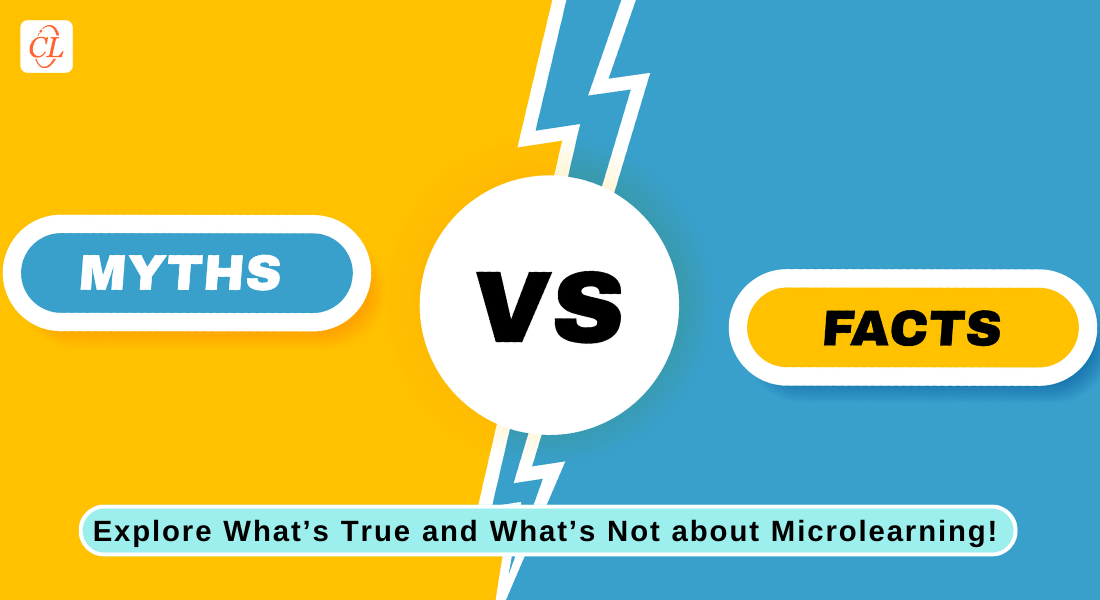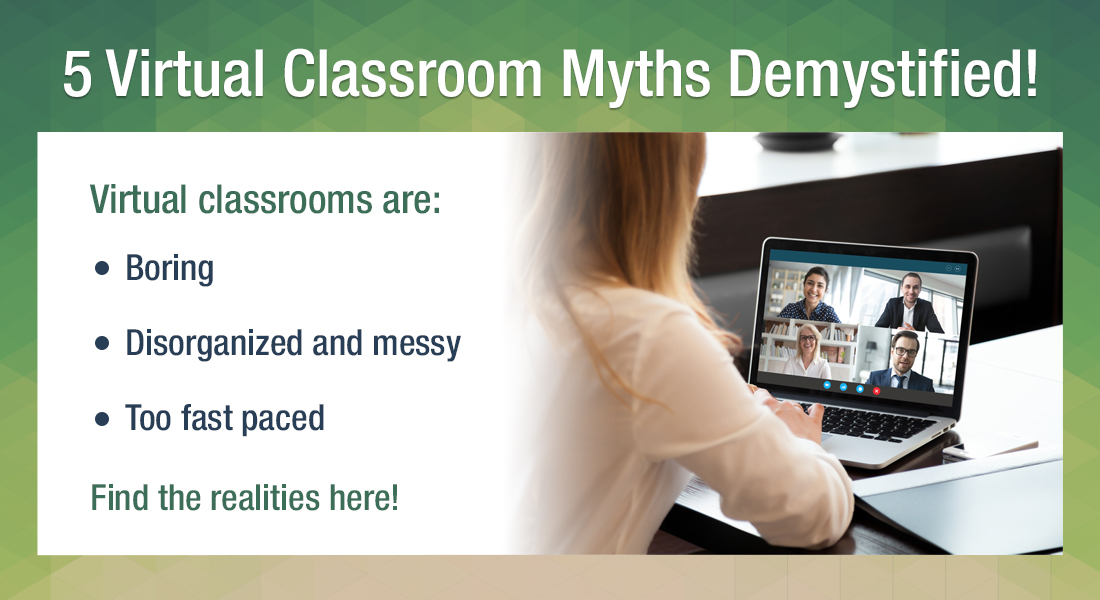6 Common Myths about Microlearning Dispelled and More!

Bats are blind… elephants are afraid of mice… duck quacks don’t echo…, and a severed earthworm regenerates into two earthworms. Well, the list of such myths is never-ending. And when spread on the internet, these myths gain traction and get people to believe in them. Like most concepts, microlearning, which is a popular training format in the eLearning industry, has also been a victim of such myth-based fads! To help you understand what microlearning truly is, this article attempts to bust myths related to microlearning and present information about microlearning that is nothing but the truth. So let’s get started!
→ Download Now: Microlearning — Where Does It Fit in Your Learning Strategy?
Table of Contents
- What Are the Common Myths About Microlearning?
- What Are the Must-Have Characteristics of Effective Microlearning Courses?
- What Training Managers Need to Know About Microlearning Deployment?
What Are the Common Myths About Microlearning?
Microlearning is all about chunking content!
That’s a huge myth… read on to know more about such myths. The article discusses:
Myth 1: Any content delivered within 5 minutes is microlearning!
Myth 2: It is time-dependent
Myth 3: It requires advanced technology
Myth 4: It is all about videos
Myth 5: It is one size fits all
Myth 1: Any Content Delivered Within 5 Minutes is Microlearning!
Well, microlearning involves chunking information and making it simple, easy-to-consume units. However, assuming any short content to be microlearning is just a delusion. It has to be understood that the length of the content is only a part of microlearning. But at the core, microlearning units need to be stand-alone, tangible pieces.
For instance, Paula wants to make a no-bake cheesecake. She types “no-bake cheesecake recipe” on YouTube and watches a 3 three-minute video. After watching the video, Paula can make a cheesecake. This can qualify as microlearning as the content is short and tangible.
Myth 2: It is Time-Dependent
Just like the delusion that short content = microlearning, the assumption that microlearning is time-dependent is also a misconception. While quick and easy, and based on need-to-know are common tags given to microlearning content, it mustn’t be tied solely to the ‘time factor’.
According to YouTube, the average video view is 4.4 minutes. However, there are a few educative videos that take longer than 5 minutes, and they still capture the learner’s attention – all thanks to the content being fun and educative.
So, the point here is that microlearning content is not time-dependent. However, the content has to be crisp, simple, engaging, and accessible on a need-to-know basis.

Where Does Microlearning Fit in Your Learning Strategy?
Uncover the Secrets to Crafting High-performing Micro Assets!
- What Microlearning is and What it is NOT?
- Types of Microlearning Assets
- Tips and Tools for Rapid Microlearning Development
- And More!
Myth 3: It Requires Advanced Technology
The power of production is an important factor to draw attention from the viewers and keep them engaged. Even learners are inclined to eLearning solutions that have good production value.
However, high-quality microlearning solutions can be developed from the convenience of homes using smartphones and laptops. There are several eLearning authoring tools available for creating high-value microlearning modules and they are quite easy to use.
Another very important thing to keep in mind is that microlearning content is more about performance support. Microlearning for performance support can take place through many forms, and not all of them call for specialized technology. Consider job aids like FAQs, checklists, decision trees, etc. Designing these assets doesn’t require high-end technology.
Myth 4: It is All About Videos
We have to agree with the fact that microlearning videos are a great way to deliver informative content. At the same time, other microlearning formats such as infographics, interactive PDFs, eBooks, quizzes, podcasts, etc., are also very impactful in delivering information to the learners. The key purpose here is to generate content that serves the learner on a ‘need-to-know’ basis.
For instance: Consider infographics – By definition, an infographic is “a visual representation of information or data”. Infographics can be used to present large chunks of data in a visual manner that is easy to consume, and visually appealing image. Similarly, decision trees can come in handy when trying to let the learners work through problem-solving issues.
So, it is true to say that microlearning is not just about videos. Several types of assets can be used to deliver microlearning content. The best suit can be determined based on the type of training provided.
Myth 5: It is One Size Fits All
One-size-fits-all is one of the biggest myths of all time! Customization and personalization are at the heart of almost all businesses. Considering that it is a part of performance support and reinforces content, microlearning units are meant to serve a specific purpose and need to come in handy on a need basis.
Considering this, it is important to understand that microlearning solutions need a clear strategy mapping out the needs of the learners and the business goals. Just adding a microlearning component to the existing L&D training initiatives is not effective. The content, the modalities, and other aspects should all be worked on according to the strategy.
Another important point to keep in mind is that microlearning cannot solve complex, behavior-based issues on its own. However, it can help and support challenging learning activities. A thorough analysis and a foolproof strategy are helpful.

Where Does Microlearning Fit in Your Learning Strategy?
Uncover the Secrets to Crafting High-performing Micro Assets!
- What Microlearning is and What it is NOT?
- Types of Microlearning Assets
- Tips and Tools for Rapid Microlearning Development
- And More!
Myth 6: It is Just Chunking Content
Well, this is a very prevalent misconception that people have about microlearning. However, microlearning is not just chunking heavy content. It is much better to define it as eLearning content delivered in bite-sized units. At the same time, microlearning content is also super specific and each microlearning nugget focuses on a specific learning objective.
Chunking of eLearning content, on the other hand, involves breaking down the content into smaller, independent modules. An example of this could be the chapters in a technical manual. These chapters are all interdependent. These chunks cannot stand alone and should be consumed in sequential order. They may not make any sense if consumed randomly.
Now that you are aware of the facts from the myths, it is easier for you to plan and implement microlearning for your corporate training. Let’s take a look at the 5 standout characteristics of effective microlearning courses.
What Are the 5 Must-Have Characteristics of Effective Microlearning Courses?
As time becomes more valuable and the exchange of information has to be quicker, it is only natural that digital learning mediums also evolve with the changing times. Microlearning has taken the helm in this pursuit of fast but effective knowledge. So let’s take a look at the distinguishing characteristics of microlearning courses.

1. Short Duration
As the name suggests, the first characteristic that makes any digital learning ‘micro’ is its short duration. Microlearning modules are designed for learners who cannot spare more than a few minutes at a time for learning and skill development. Keeping the duration short enables users to quickly gain knowledge and make the most of the little spare time they might have.
As microlearning is largely accessed from mobile devices, keeping the duration short and content crisp keeps the learner engaged even on devices with limited screen sizes. Bite-sized module means that learners are more motivated to undertake the training as they can learn a useful skill or gain some important knowledge quickly, at the moment of need.
2. Focus on a Single Learning Objective
No doubt that short duration really limits the amount of information that can be conveyed through a course. But microlearning uses this limitation to its advantage. Microlearning modules are designed to cover just one learning objective and focus on including the necessary and relevant information. It helps keep the microlearning module more focused on providing learners with quantifiable learning outcomes. Instead of learning about a lot of things haphazardly, a single learning objective allows learners to learn just one topic efficiently.
For example: When the training has to convey instructions to operate equipment or the safety procedure to be followed during an operation, it is best to have a single learning objective to boost knowledge transfer and retention.
3. Microlearning Is Independent, Even If Part of a Whole
One of the reasons microlearning works so well is because of its standalone nature. Microlearning modules do a great job of delivering a particular lesson independently. A true micro-module is self-sufficient and does not require learners to have studied any preceding sessions. Even if some portions of the module require additional information, that cannot be part of the module, external links and references can be provided to the learners.
That being said, a microlearning module can never exist on its own due to its small size. This means it can never convey an entire topic on its own, and it will always be part of a larger eLearning course. But since it is self-sufficient, the same micro module can be used in any course that might have the micro topic under its curriculum.
4. Include Multimedia Elements and Interactivities
As microlearning modules are a shorter duration, it is loaded with interactive elements. Interactivity allows your learners to apply what they’ve learned, which helps them commit information to their long-term memory. Instead of just passively reading about the subject matter or watching an eLearning video, interactive elements serve as an active form of online training.
Simulations, drag-and-drop interactions, eLearning games, and clickable walkthroughs all can be a part of your microlearning module that gives your learners the chance to put their knowledge and skills into practice. It also provides immediate feedback, enabling them to correct performance behaviors on the spot. They can even repeat the activity when the need arises, to perfect their problem-solving approach.
5. Design Responsive Microlearning Modules
Due to its short duration and engaging nature, learners access microlearning modules from multiple devices. Whenever learners get a little free time on their hands they use their smartphones, tablets, and laptops to access the course, irrespective of their location. One of the most important technical aspects a microlearning module has to fulfill is its ability to work on multiple devices.
Using a responsive design approach is the best way to ensure your course works flawlessly across any device of any size and functionality. A responsive course adapts its elements and optimizes the display according to the screen size in use. Thus, every member of your audience will receive the same experience from your digital micro-training course. Responsive design is ideal for microlearning because it delivers mobile-ready online training content giving learners unmatched flexibility.
Microlearning is becoming the most preferred training format and all thanks to its interesting nugget-sized learning bites. Hope the characteristics discussed in the blog helped you understand what goes into an engaging microlearning course.

Where Does Microlearning Fit in Your Learning Strategy?
Uncover the Secrets to Crafting High-performing Micro Assets!
- What Microlearning is and What it is NOT?
- Types of Microlearning Assets
- Tips and Tools for Rapid Microlearning Development
- And More!
What Training Managers Need to Know About Microlearning Deployment?
We’ve seen that bite-sized chunks of easily digestible information are perfect for our fast-paced lives and shrinking attention spans. But as a training manager, before hopping on this trendy train, understanding microlearning's true potential and limitations is crucial. This section will offer key insights that you should be aware of before deploying microlearning.
1. Microlearning is a Targeted Tool, not a Magic Wand!
While microlearning shines in specific situations, it's not a universal solution. Complex skill development or in-depth knowledge acquisition still requires comprehensive approaches. So identify where microlearning truly integrates best. Some of the areas where you can leverage microlearning for corporate training can be:
- Onboarding: Instead of overwhelming new hires with information overload, introduce basic processes, tools, and company culture through bite-sized, engaging microlearning modules. This eases them into their roles and sets them up for success.
- Skills Reinforcement: Keep key skills sharp and top-of-mind with short, engaging practice exercises delivered through microlearning courses. A few minutes daily spent practicing vital skills through interactive microlearning assets leads to better retention and application in real-world scenarios.
- Performance Support: Forget bulky manuals! Offer quick just-in-time information through microlearning. Short, targeted modules on specific procedures or troubleshooting steps can equip employees to handle situations immediately, improving efficiency and performance.
- Compliance Updates: Ensure everyone stays compliant with ever-changing regulations and policies by delivering essential updates in digestible doses through microlearning. Short, impactful microlearning design helps in highlighting key changes and best practices keep your workforce informed and compliant.
2. Learning Objectives are the North Star
Don't get lost in the "micro" excitement. Before jumping right into designing and developing microlearning, start with clear and specific learning objectives for microlearning modules. What knowledge, skills, or attitudes do you want learners to gain? Break down these broader goals into achievable micro-achievements. Each microlearning nugget should contribute to the overall learning journey, ensuring a focused and impactful experience.

3. Content is King (and Queen, and Prince, and Jester)
Engaging content is the lifeblood of successful microlearning. Opt for variety to keep learners hooked. Utilize the power of video demonstrations, interactive simulations, gamified elements, infographics, and bite-sized podcasts to deliver information in a visually appealing and interactive way. Remember, micro doesn't mean low quality. Invest in high-quality content that resonates with your learners and leaves a lasting impact.
4. Sequencing: Building a Coherent Learning Journey
Now that your individual modules are polished, don't just dump them into your LMS. The sequencing of these modules is crucial for creating a meaningful learning experience.
Here are some key points to remember when sequencing microlearning modules:
- Start with the Foundation: Begin with modules that introduce core concepts and principles. Laying this essential groundwork allows learners to grasp more complex topics presented later.
- Build in Logical Progression: Arrange modules in a way that builds upon each other.
5. Technology: Your Essential Ally
Don't let microlearning content delivery become a hurdle. Choose a learning management system (LMS) that seamlessly integrates microlearning. It should offer ease of access, mobile compatibility, offline learning options, tracking capabilities, and comprehensive reporting tools. Streamline the learning experience and gain valuable insights into learner engagement and progress.
Know more about LMS [Watch Video]
6. Measurement Matters: Data Tells the Story
Launching and forgetting is a recipe for mediocrity. Evaluate the effectiveness of your microlearning initiatives. Track completion rates, knowledge gained through pre- and post-assessments, and most importantly, performance improvement in the workplace. Use data to refine your approach, iterate on existing modules, and measure the return on investment your microlearning programs deliver.
7. Promote and Encourage: Building a Learning Culture
Don't expect learners to magically stumble upon your microlearning treasures. Proactively promote them through regular communication channels, integrate them into employee workflows, and leverage social learning opportunities through discussion forums and leaderboards. Gamification elements can further incentivize participation and create a culture of continuous learning.
8. Sustainability: The Gift that Keeps on Giving
Microlearning is a long-term commitment, not a short-term fix. Plan for ongoing content creation and expansion. Regularly update your training modules with fresh information and adapt to changing needs. Ensure your microlearning course library stays relevant and engaging, and addresses the evolving learning needs of your workforce.
Wrapping Up
And that’s a wrap but before saying bye, we would like to share - microlearning is a powerful tool when used strategically. As a training manager, use it wisely, and you'll unlock a world of engaging, impactful learning experiences that empower your team to achieve their full potential. Check out our handy guide will help you find where microlearning fits in your learning strategy. Download now!
Editor’s note: This post was originally published on November 03, 2022 and has been updated for comprehensiveness.






![6 Microlearning Myths Debunked [Infographic]](https://blog.commlabindia.com/hubfs/Imported_Blog_Media/microlearning-features-for-corporate-training-infographic-1.jpg)